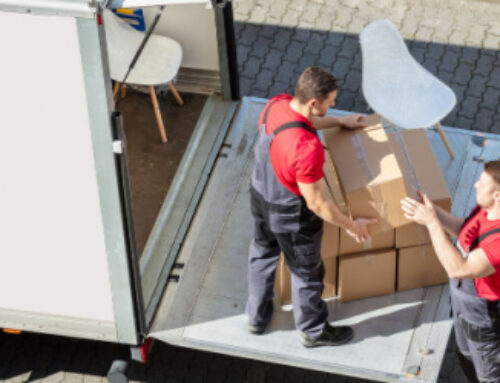After nearly 40 years of helping individuals and families relocate from one home to another, we’ve got a pretty intimate glance into the kinds of things that people collect. They run the gamut from Hummel figurines to rare coins to vinyl records to surfboards. The list is practically endless!
However, there’s one kind of collection that our surveyors always look out for: a big library of books. Why? Books are heavy, and they pack very densely into boxes. And, since your move will ultimately be priced by weight, a big library of books can quickly change the cost of your move.
Because of their weight, it’s important to know how to pack books—and to pack them right. Throwing them willy-nilly into boxes can end up damaging your book collection permanently. Can you imagine paying to move your entire library from Hawaii to the mainland (or the reverse), only to end up with a bunch of warped books? Just the thought of it makes us cringe.
In this article, we’ll help you avoid that fate by showing you everything you need to know when you’re packing books for a move. We’ll also show you how to pack your books like a pro, so that even if your library sits in storage for a few months—or the boxes sit in your house for a few weeks before you unpack them—your books will come out of the move in the same pristine condition you packed them in.
Tip #1: Re-Home As Many Tomes As Possible
Before you make any moves toward packing your library, it’s important to start by downsizing your library. As we mentioned above, your move will ultimately be priced by weight, so any books that you can bear to get rid of will directly reduce the cost of your move. Some of these decisions will be easy, especially if you’ve been, say, holding on to those old college textbooks, just in case. Others may require some careful consideration.
Every move is unique, so we can’t tell you exactly how much to downsize. However, asking yourself questions like, “Will I really re-read this book?” or “Am I sure this is something that my children will be interested in someday?” are a good start. You might also consider gifting books to friends or donating books to charitable organizations in your area.
Pro Tip: If you’re making a minimalist move and you have a small(ish) library you want to take with you, take a look into shipping your books via USPS Media Mail. While it can take a few weeks for mainland–Hawaii shipments, it’s one of the most cost-effective ways to relocate books.
Then, when you’re confident that you’ve trimmed your library down to the right size, you’re ready to move on to the next step.
Tip #2: Sort Your Books
Once you’ve downsized, it can be tempting to jump right into the packing phase without any further preparation. Making a big move comes with a long to-do list, and filling boxes can feel like real progress.
However, if you’ll take some time to sort your books, you’ll save yourself a lot of work in the long run. Think in three categories:
#1: Old, Valuable, or Fragile Books
If you’re a serious collector with a number of first editions, you’ll want to handle those books differently. Ideally, pack these in acid-free paper, with plenty of packing paper in between to make sure they don’t get damaged. In fact, if you have any really valuable books, you may want to ship them separately to ensure that they arrive at your new home in pristine condition. (And don’t forget to insure them, just in case!)
#2: Read/Unread Books
While it’s not a must, it can be helpful to separate your collection into two piles: books you’ve read and books you haven’t read. These categories can be especially useful if it takes you a few weeks to fully unpack your house. With an “unread” box packed and labeled, you’ll find it easy to locate your next great read.
#3: Books of Similar Sizes
Although there are a few standard sizes, books come in all kinds of heights and widths. By creating groups of like-sized volumes, you’ll find it much easier to pack them snugly in their boxes in a way that minimizes damage or warping. (You’ll see what we mean as soon as you work on your first box!)
Tip #3: Get the Right Boxes
As professional movers, we can be pretty picky about the boxes we use—and with good reason. New boxes provide the best protection for your belongings, especially when you’re doing a long-distance move.
Can you grab boxes from the local liquor store? If you must. Just be aware that cardboard degrades with each use, so they won’t be as strong as new boxes.
One non-negotiable? Skip any boxes that have been used to hold food. Pre-packaged food like cans are okay, but don’t put your books in a box that held, for example, lettuce. Any leftover food residue can attract insects and contaminate your books. This is especially important if your belongings will be in storage for any length of time.
Finally, make sure to keep your boxes on the smaller size. Boxes full of books can get heavy fast, so keeping the box size small will ensure that your book boxes are easy to lift and carry.
Tip #4: Pack Smart to Minimize Warping
Now, we’re ready to dive into the actual packing! As you start to load your boxes with books, your biggest priority should be packing in a way that reduces the possibility of warped or bent books. Storing books at an angle—or dropping them haphazardly into a box without a lot of thought—can result in a wonky-looking book that may never return to its original appearance.
Everybody has their own method that they swear by, and you’ll have to get a little creative based on your library. However, as an overall rule of thumb, know that the spine is the strongest part of any book. So if there’s any weight or pressure on your books, you want the spine to bear it, not the unbound edges.
To guide you, we’ve got a couple of dos and don’ts:
Do:
- Lay the books flat in the box, with the covers facing you. If you have enough room to create a second column, line them up so the books are spine to spine.
- You can also stand your books up in the box, as though they’re sitting on a bookshelf. If you go this route, alternate books spine in and spine out to offer a balanced structure to the row.
- You can also pack books spine-down, but you don’t want to stack a second row of books on top, or you’ll risk the possibility of bending the books.
- Use crumpled packing paper to fill any gaps in your box. You might also want to consider a layer of packing paper in the bottom of the box and a crumpled layer at the top to give your books some extra cushioning.
Don’t:
- Put any books at an angle or pack them in a bent position.
- Arrange books with the spines up and the pages down toward the bottom of the box. This might lead to bent books.
- Leave any empty spaces in the box. This sets the stage for books to slide around and get damaged. Instead, use crumpled packing paper to keep books in place as you move.
Tip #5: Tape, Tape, Tape
Did we mention that books are heavy?! Because of this, you’ll want to make sure that you tape your boxes well to keep all those carefully packed books where they belong. We recommend using three pieces of tape: one right down the middle where the bottom flaps come together, then two more on either side, parallel to the first piece to reinforce the box’s edges.
Tip #6: Label Smart and Label Often
When you’re packing in a hurry, this is one of those things that can get dropped from the list. However, if you find yourself in desperate need of that classic Julia Child cookbook so you make can her famous Boeuf Bourguignon, you’ll be glad you labeled your boxes well. Whether or not you decide to go down the “read/unread” path, you may want to also label by genre—cookbooks, children’s books, fiction, etc.—so it will be easy to find what you’re looking for on the other end.
And, finally . . .
Tip #7: Load Smart
If you’ve hired movers for a door-to-door Hawaii move, you won’t have to worry about this piece. However, if you’re doing the packing yourself, make sure to put book boxes on the floor of your truck or container. It’s tempting to stack them, but unless you secure them tightly in place, these heavy stacks may shift around and crush other things. Instead, it’s better to use them as a solid base for your less heavy (and less durable!) items.
Making Your Hawaii Move One for the Books
Some people can’t imagine a world without their books. The good news is that, with these tips in hand, you won’t have to! A little careful planning and packing will ensure that your books make the journey with you—and arrive safely—so that you can continue to work your way through library, book by book.
_____
Want some help moving your books (and the rest of your household!) to and from Hawaii? We’d love to help you make a safe, easy, and affordable move. Plus, with a complimentary in-home survey from one of our experts, we can help you figure out exactly how much it will cost to take your library with you! Get started by requesting your free quote.



